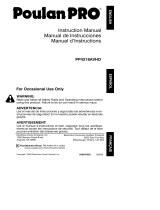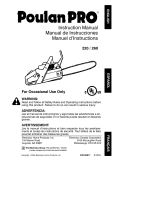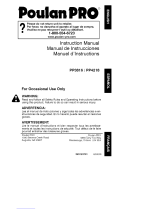
19
LIMITED WARRANTY
Poulan PRO, a division of Husqvarna Con-
sumer Outdoor Products N.A., Inc., war-
rants to the original consumer purchaser that
each new Poulan PRO brand gasoline chain
saw is free from defects in material and
workmanship and agrees to repair or replace
under this warranty any defective gasoline
chain saw as follows from the original date of
purchase.
2 YEARS -- Parts and Labor, when used for
household purposes.
60 DAYS -- Parts and Labor, when used for
commercial, professional, or income pro-
ducing purposes.
30 DAYS -- Parts and Labor, if used for rental
purposes.
This warranty is not transferable and does
not cover damage or liability caused by im-
proper handling, improper maintenance or
alteration, or the use of accessories and/or
attachments not specifically recommended
by Poulan PRO for this chain saw. This war-
ranty does not cover tune--up, spark plugs,
filters, starter ropes, chain sharpening, bars,
chains, and other parts which wear and re-
quire replacement with reasonable use dur-
ing the warranty period. This warranty does
not cover predelivery setup, installation of
guide bar and chain, and normal adjust-
ments explained in the instruction manual
such as chain tension adjustments. This
warranty does not cover transportation
costs.
In the event you have a claim under this war-
ranty, you must return the product to an au-
thorized service dealer.
Should you have any unanswered questions
concerning this warranty, please contact:
Poulan PRO, a division of Husqvarna
Consumer Outdoor Products N.A., Inc.
7349 Statesville Road
Charlotte, NC 28269
1--800--554--6723 In Canada, contact:
Poulan PRO
850 Matheson Blvd. West
Mississauga, Ontario L5V 0B4
Giving the model number, serial number and
date of purchase of your product and the
name and address of the authorized dealer
from whom it was purchased.
THIS WARRANTY GIVES YOU SPECIFIC
LEGAL RIGHTS, AND YOU MAY HAVE
OTHER RIGHTS WHICH VARY FROM
STATE TO STATE.
NO CLAIMS FOR CONSEQUENTIAL OR
OTHER DAMAGES WILL BE ALLOWED,
AND THERE ARE NO OTHER EXPRESS
WARRANTIES EXCEPT THOSE EX-
PRESSLY STIPULATED HEREIN.
SOME STATES DO NOT ALLOW LIMITA-
TIONS ON HOW LONG AN IMPLIED WAR-
RANTY LASTS OR THE EXCLUSION OR
LIMITATIONS OF INCIDENTAL OR CON-
SEQUENTIAL DAMAGES, SO THE
ABOVE LIMITATIONS OR EXCLUSION
MAY NOT APPLY TO YOU.
This is a limited warranty within the meaning
of that term as defined in the Magnuson--
Moss Act of 1975.
The policy of Poulan PRO is to continuously
improve its products. Therefore, Poulan
PRO reserves the right to change, modify, or
discontinue models, designs, specifications,
and accessories of all products at any time
without notice or obligation to any purchaser.
U.S. EPA/CALIFORNIA/ENVIRONMENT CANADA
EMISSION CONTROL WARRANTY STATEMENT
YOUR WARRANTY RIGHTS AND OB-
LIGATIONS: The U.S. Environmental
Protection Agency, California Air Resources
Board, Environment Canada and Poulan
PRO are pleased to explain the emissions
control system warranty on your year 2010 and
later small off--road engine. In California, all
small off--road engines must be designed, built,
and equipped to meet the State’s stringent
anti--smog standards. Poulan PRO must
warrant the emission control system on your
small off--road engine for the periods of time
listed below provided there has been no
abuse, neglect, or improper maintenance of
your small off--road engine. Your emission
control system includes parts such as the car-
buretor, the ignition system and the fuel tank.
Where a warrantable condition exists, Pou-
lan PRO will repair your small off--road en-
gine at no cost to you. Expenses covered un-
der warranty include diagnosis, parts and
labor. MANUFACTURER’S WARRANTY
COVERAGE: If any emissions related part
on your engine (as listed under Emissions
Control Warranty Parts List) is defective or a
defect in the materials or workmanship of the
engine causes the failure of such an emission
related part, the part will be repaired or re-
placed by Poulan PRO. OWNER’S WAR-
RANTY RESPONSIBILITIES: As the small
off--road engine owner, you are responsible
for the performance of the required mainte-
nance listed in your instruction manual. Pou-
lan PRO recommends that you retain all re-
ceipts covering maintenance on your small
off--road engine, but Poulan PRO cannot
deny warranty solely for the lack of receipts
or for your failure to ensure the performance
of all scheduled maintenance. As the small
off--road engine owner, you should be aware
that Poulan PRO may deny you warranty
coverage if your small off--road engine or a
part of it has failed due to abuse, neglect, im-
proper maintenance, unapproved modifica-
tions, or the use of parts not made or ap-
proved by the original equipment
manufacturer. You are responsible for pres-
enting your small off--road engine to an Poulan



























